 klaus-michael schneider
klaus-michael schneider
Keywords: colombia | ministries |
Links: FOTW homepage | search | disclaimer and copyright | write us | mirrors

FOTW beschäftigt sich mit der Wissenschaft der Vexillologie (Flaggenkunde).
Alle auf dieser Website dargebotenen Abbildungen dienen ausschließlich der Informationsvermittlung im Sinne der Flaggenkunde.
Wir distanziert uns ausdrücklich von allen hierauf dargestellten Symbolen verfassungsfeindlicher Organisationen.
Last modified: 2021-08-26 by  klaus-michael schneider
klaus-michael schneider
Keywords: colombia | ministries |
Links: FOTW homepage |
search |
disclaimer and copyright |
write us |
mirrors
See also:
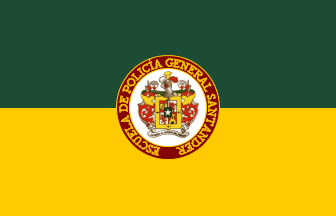 image by Eugene Ipavec, 2 October 2005
image by Eugene Ipavec, 2 October 2005
obverse
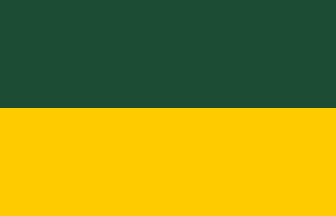 image by Eugene Ipavec, 7 March 2006
image by Eugene Ipavec, 7 March 2006
reverse
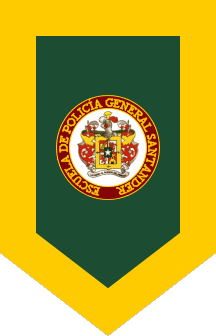 image by Eugene Ipavec, 14 October 2009
image by Eugene Ipavec, 14 October 2009
pennant
Flag of the "Escuela de Cadetes de Policía General
Santander" (General Santander Police Cadet School).
Description of the flag: two equal horizontal stripes, top green
and bottom yellow, with Coat of Arms on the middle. Official
website: Dirección
Escuela Nacional de Policía General Santander.
E.R., 22 September 2005
There seems to be a gold inscription in the burgundy ring
around the arms, but it's far too small to be legible. The name
of the school, perhaps, or its motto?
Eugene Ipavec, 22 September 2005
The inscription on the golden fringe is the name of the
School, so it would be (in golden capital letters) "ESCUELA
DE POLICA GENERAL SANTANDER".
E.R., 2 October 2005
I observed the General Santander Police Cadet School
Pennant/Guidon at a military parade held on July 20, 2009 on the
Municipality of Tame, Department of Arauca. There's an image
gallery where you can see the Pennant/Guidon of the School on
the instruments of the marching band during the parade.
E.R., 14 October 2009
 image located by Esteban Rivera, 21 December 2013
image located by Esteban Rivera, 21 December 2013
In the Main Hall of the Historic Museum of the National Police, one can see
the flag of the General Santander Police Cadet School. However, the flag I saw
is very different in color shade to the one featured.
Source: picture taken on March 10, 2010 at the Historic Museum of the National
Police.
Notice that both, the shade of green and yellow on the flag are very different
from the one reported.
Esteban Rivera, 21 December 2013
 image located by Esteban Rivera, 21 December 2013
image located by Esteban Rivera, 21 December 2013
We have the Standard of the School but not the War Flag.
So here's the War Flag (Colombian tricolor with the School's name):
http://sphotos-e.ak.fbcdn.net/hphotos-ak-prn1/554936_10200497348495577_644261044_n.jpg
Esteban Rivera, 25 February 2013
Why would a school need a war flag?
Peter Hans van den Muijzenberg, 12 July 2013
As far as I understand, a Standard is the flag with heraldic devices of any
military entity and the War Flag is (in this case) the Colombian tricolor plus
the name of the entity around the coat of arms. Since all Colombian military and
police units have both, a Standard and a War Flag, I had not seen the War Flag
for the General Santander Police Cadet School, so that's why I reported it.
Esteban Rivera, 12 July 2013
The War Flag is the Colombian tricolor plus the entity's name below in a golden
fringe, this pattern used for most official civilian and military organizations
(Pictures downloaded on June 15, 2009, but don't
remember the source)
Esteban Rivera, 21 December 2013
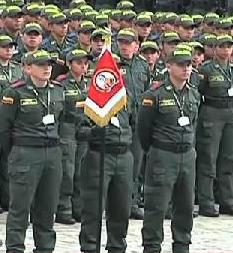 image located by Esteban Rivera, 16 April 2015
image located by Esteban Rivera, 16 April 2015
Two days ago in the news edition of April 14, 2015 by CM& tv news, during
their broadcast they showed a pennant belonging to EGSAN (Escuela General
Santander). In this pennant, the bust of General Santander is
featured on a horizontal red background pennant.
Source:
https://www.youtube.com/watch?v=aQIN8E9xh90&feature=youtu.be at 10:09
Esteban Rivera, 16 April 2015
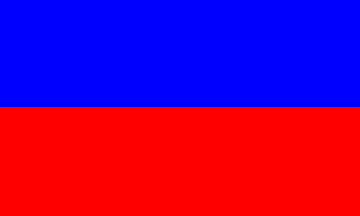 image by Ivan Sache, 26 October 2016
image by Ivan Sache, 26 October 2016
Carabineers' School Rafael Núñez (Escuela de Carabineros "Rafael Núñez" -
ESRAN) is located in Corozal (Sucre Department). ESRAN is named for Rafael Núñez
(1825-1894), Governor of the Sovereign State of Panamá (1858) and of Cartagena
Province 1854-1855) and President of Colombia (1880-1882; 1884-1886; 1887-1888:
1892).
The flag of ESRAN is in size 2.00 m in length on 1.20 in width,
made of two horizontal stripes, each of 0.60 m in width, the upper, blue, and
the lower, red.
Blue means identity, equanimity and professional
relevance, united to the red stripe to represent the sacrifice of blood when
necessary to defend the institute's motto, "Integridad y Orden" (Integrity and
Order). The meaning of the colors is also the same as on the national flag, the
sky and water of the Caribbean Sea, lakes and swamps, and the sacrifice of the
ancestors for liberty and independence and the creation of the republic.
https://www.policia.gov.co/escuelas/rafael-nunez/simbolos
National
Police website
Ivan Sache, 26 October 2016
It is important to notice that the HQ for the Carabineers' School is the
Escuela Nacional de Carabineros (ESCAR)"Alfonso López Pumarejo" (English:
"Alfonso Lopez Pumarejo" National Carabineers School) located in Facatativá. The
flag (https://www.policia.gov.co,
source:
https://www.policia.gov.co/escuelas/carabineros/simbolos) and coat of arms (https://www.policia.gov.co,
source:
https://www.policia.gov.co/escuelas/carabineros/simbolos) are located on
their official website (https://www.policia.gov.co/escuelas/carabineros).
Now, they have other Carabineers' School branches as well, as follows:
Escuela de Carabineros "Alejandro Gutiérrez" (ESAGU) (English: "Alejandro
Gutierrez" Carabineers School) located in Manizales: Flag (https://www.policia.gov.co,
source:
https://www.policia.gov.co/escuelas/alejandro-gutierrez/simbolos), coat of
arms (https://www.policia.gov.co,
source:
https://www.policia.gov.co/escuelas/alejandro-gutierrez/simbolos), official
website (https://www.policia.gov.co/escuelas/alejandro-gutierrez)
Escuela de Carabineros "Eduardo Cuevas" (ESECU) (English: "Eduardo
Cuevas"
Carabineers' School) located in Villavicencio Flag (https://www.policia.gov.co,
source:
https://www.policia.gov.co/escuelas/alejandro-gutierrez/simbolos), coat of
arms (https://www.policia.gov.co,
source:
https://www.policia.gov.co/escuelas/eduardo-cuevas/simbolos), official
website (https://www.policia.gov.co/escuelas/eduardo-cuevas)
Escuela de Carabineros "Rafael Núñez" (ESRAN) (English: "Rafael Núñez"
Carabineers' School) located in Corozal: Flag (https://www.policia.gov.co,
source:
https://www.policia.gov.co/escuelas/rafael-nunez/simbolos), coat of arms (https://www.policia.gov.co,
source:
https://www.policia.gov.co/escuelas/rafael-nunez/simbolos), official website
(https://www.policia.gov.co/escuelas/rafael-nunez)
Escuela de Carabineros Provincia de Vélez "Mayor General Manuel José López Gómez"
(ESVEL) (English: "Mayor General Manuel José López Gómez" Vélez Province
Carabineers' School) lcoated in Vélez Flag (https://www.policia.gov.co,
source:
https://www.policia.gov.co/escuelas/provincia-velez/simbolos), coat of arms
(https://www.policia.gov.co,
source:
https://www.policia.gov.co/escuelas/provincia-velez/simbolos), official
website (https://www.policia.gov.co/escuelas/provincia-velez).
Sources:
https://es.wikipedia.org/wiki/Direcci%C3%B3n_Nacional_de_Escuelas and
https://es.wikipedia.org/wiki/Direcci%C3%B3n_de_Carabineros_y_Seguridad_Rural
So the ESRAN that Ivan mentions is one of those branches.
All of
the above depend on the DINAE regarding the
Schools (administrative level), and depend on the
DICAR (operational level).
Esteban Rivera, 26 October 2018
 image by Eugene Ipavec, 11 August 2006
image by Eugene Ipavec, 11 August 2006
flag
.gif) image by Eugene Ipavec, 11 August 2006
image by Eugene Ipavec, 11 August 2006
coat of arms
Escuela Carlos E. Restrepo (SERES), located in La Estrella, Departamento de Antioquia.
Source: www.policia.gov.co.
E.R., 30 August 2006
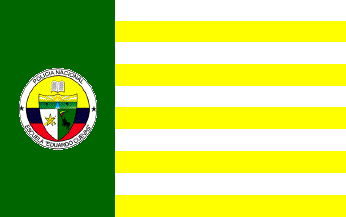 image by Eugene Ipavec, 28 March 2016
image by Eugene Ipavec, 28 March 2016
Escuela Eduardo Cuevas was inaugurated on 1 December 1959 in Viilaviciencio
(Meta). Transferred to Orocué (Casanare) on 1 October 1967, the institute was
repatriated to Viilaviciencio by Resolution No. 4,663 of 5 July 1972. The
institute is named for Eduardo Cuevas García (1896-1965), appointed commander of
the Police 10th Division in 1937 and founder of the 11th Division, established
by Decree no. 2,016 of 22 October 1937.
Source:
Official website
The flag of Escuela Eduardo Cuevas is vertically divided. The third left part of
the flag is green, the colour of the Colombian police, charged in the center
with the emblem of the school. The right part of the flag is horizontally
divided in ten horizontal stripes, in turn white and yellow. In combination with
green, white and yellow are the colours of the Carabiniers.
The flag is prescribed by Resolution No. 166 of 25 October 1960. Its size is 110
cm x 135 cm, each coloured stripe being 10 cm in height [the dimensions do not
make sense, the photo of the flag rather indicates proportions 5:8]. The size of
the emblem on the flag is 45 cm x 40 cm.
The emblem of Escuela Eduardo Cuevas is made of the school's coat of arms
surmounted by a white open book with letters sable, symbolizing knowledge. The
whole is placed on a circular background horizontally divided yellow-blue-red
(2:1:1) and bordered by a white ring inscribed with POLICIA NACIONAL (top) and
ESCUELA "EDUARDO CUEVAS" (bottom), separated by two five pointed stars placed on
each side of the ring. The shield is in Swiss shape, without outer ornamentation.
The dexter part is argent, charged with s star superimposed by an arrow and a
rifle in saltire, all or. The sinister part is vert, charged with a centaur or
rampant, characteristic of the savannah, raising a standard to the colours of
Colombia.
The chief of the arms features the sun rising over a landscape made of plains,
pastures and green palms, crossed by a river, representing the braveness of the
inhabitants of the region aspiring to a better future (vert).
Source:
Official website
Eugene Ipavec, 28 March 2016
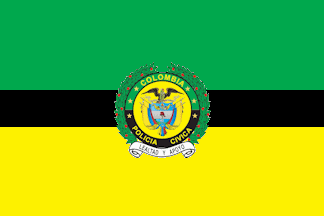 image by Randy Young, 24 May 2018
image by Randy Young, 24 May 2018
The "Escuela de Policía Gabriel González, ESGON" (English: Gabriel Gonzalez
Police School) is located in El Espinal, Tolima. It
was
established through Resolution No. 01967 of July 24, 1957, by the General
Directorate.
Source:
https://www.youtube.com/watch?v=bJUB-MWY4lE
The flag is a horizontal
flag equally divided into three horizontal stripes (green on top, yellow in the
middle and purple on bottom)
featuring
the coat of arms in the middle, as seen here:
https://www.policia.gov.co/ (source:
https://www.policia.gov.co/noticia/327-auxiliares-policia-juraron-bandera).
The flag measures 1.35m long by 1.10m tall. The coat of arms was granted through
Resolution No. 08985 of November 1980, by the General Directorate.
Source:
https://www.policia.gov.co/escuelas/gabriel-gonzalez/simbolos
For
additional information go to (official website):
https://www.policia.gov.co/escuelas/gabriel-gonzalez
Esteban Rivera,
21 May 2018
 image by Ivan Sache, 22 December 2018
image by Ivan Sache, 22 December 2018
Vélez Province Carabineers' School Mayor General Manuel José López Gómez (Escuela
de Carabineros Provincia de Vélez "Mayor General Manuel José López Gómez" -
ESVEL) is located in Vélez (Santander Department).
The symbols of ESVEL
are prescribed by Internal Order No. 136, issued on 19 October 1999.
The flag
is diagonally divided from the lower left to the upper right corner, the upper
part white and the lower part green, by a narrower yellow stripe, in width 1/6
of the flag's hoist. In the center of the stripe is placed the school's coat of
arms. White represents the institutional vision. Green represents honor, vigor
and respect. Yellow means light, constancy, knowledge and nobleness.
The
coat of arms is in Spanish Carlist shape, quartered with a bordure and a scroll
inscribed "SABIDURÍA, LEALTAD, HONOR" (Knowledge, Loyalty, Honor). The
upper quarter features on a field argent an open book, a quill and an ink pot,
representing knowledge. The lower right quarter features a cordillera vert, a
sky azure, a tiple guitar, a poncho and a branch of guava, representing the
region. The upper right quarter features a horse on a field vert.
The
yellow bordure represents nobleness, sincerity and maturity. It is inscribed in
the upper part with "ESCUELA DE CARABINEROS" and in the lower part with
"PROVINCIA DE VÉLEZ". The shield is surmounted with the carabineers' insignia,
made of a saber, symbolizing nobleness and a rifle symbolizing rural vigilance.
The five-pointed star means adoration to the world's supreme ruler [God],
representing the five divine attributes: Greatness, Truth, Light, Majesty and
Peace. It is placed on a rising sun, as a symbol of power and constancy. Beneath
the shield, a yellow scroll is inscribed with the institutional motto,
"SABIDURÍA, LEALTAD, HONOR" (Wisdom, Loyalty, Honor) in black letters.
https://www.policia.gov.co/escuelas/provincia-velez/simbolos, National
Police website
Ivan Sache, 22 December 2018
 image by Ivan Sache, 19 October 2018
image by Ivan Sache, 19 October 2018
Miguel Antonio Caicedo Mena Police School (Escuela de Policía de Yuto "Miguel
Antonio Caicedo Mena" de la Policía Nacional - ESMA) is located in Yuto (Chocó,
Quibdó Department). The school is named for the local poet Miguel Ángel Caicedo
Mena (1919-1995).
The flag of ESMAC is composed of three colors, green,
blue and yellow, arranged in three horizontal stripes; the green stripe, located
in the upper part, covers one half of the flag, while the two other ones each
cover one fourth of the panel, the blue stripe being in the center.
Green
represents the biodiversity formed by the rain forests of the Colombian Pacific
region.
Blue represents the water resources of the Colombian Pacific region.
Yellow represents the main ore, gold, which is the symbol of the hopeless
struggle of our ancestors who shed their blood to preserve it.
https://www.policia.gov.co/escuelas/yuto/simbolos
Ivan Sache,
19 October 2018
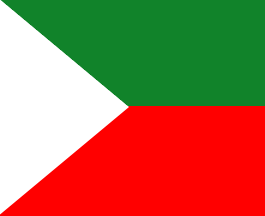 image by Ivan Sache, 14 December 2018
image by Ivan Sache, 14 December 2018
flag
.gif) image by Eugene Ipavec, 30 August 2006
image by Eugene Ipavec, 30 August 2006
coat of arms
Escuela Rafael Reyes (ESREY), located in Santa Rosa de Viterbo, Department of Boyacá.
Source: www.policia.gov.co
E.R., 30 August 2006
The school is named for Santa Rosa de Viterbo-born Rafael Reyes Prieto
(1849-1921), President of Colombia from 1903 to 1909.
The flag of ESREY
is based on the flag of Santa Rosa de Viterbo. Its size is 1.35 m in length on
1.10 m in width.
The flag is composed of two horizontal stripes of equal
size; the upper, green, and the lower, red, with a white equilateral triangle
placed at hoist.
Green is a symbol of the resources of the fields and hope.
Red represents blood shed by the town's citizens in the struggle for
emancipation.
White represents the exuberance and limpidity of the spirit of
the women from Boyacá.
https://www.policia.gov.co/escuelas/rafael-reyes/simbolos, National Police
website
Ivan Sache, 14 December 2018
 image by Ivan Sache, 16 December 2018
image by Ivan Sache, 16 December 2018
Simón Bolívar Police School (Escuela de Policía "Simón Bolívar" - ESBOL) is
located in Tuluá (Valle del Cauca Department).
The flag of ESBOL, based
on the flag of Tuluá, is horizontally divided red-green-white with the school's
coat of arms all over. Red represents strength, triumph, audacity and highness.
Green is the police's institutional color, representing faith, friendship,
service and respect. White represents purity, loyalty, sincerity, clearness and
peace.
The coat of arms of ESBOL is prescribed by Resolution No. 6,710,
issued on 14 August 1980. The shield is round (Hispanic-Arab shape). The upper
field, azure, features a dove passant argent beaked and membered gules with a
band azure on the eyes and holding in the beak a branch of olive with eight
leaves fileted sable. The lower left field is vert with a book or covered with
11 lines sable. The lower right quarter is purpure with an oil lamp argent
burning or.
The shield is surrounded by a circle, in the upper half, or
inscribed "ESCUELA DE POLICÍA SIMON BOLÍVAR" in letters sable, and in the lower
half, argent inscribed "ESTUDIAMOS POR SERVIR" [We Study to Serve]. The circle
represents infinite perfection: God. Argent is noble in heraldry, representing
integrity, sincerity, obedience, firmness, vigilance, eloquence and triumph.
Gules and vert have the same meaning as green and red on the flag, respectively.
Purpure represents greatness and knowledge.
https://www.policia.gov.co/escuelas/simon-bolivar/simbolos, National Police
website
Ivan Sache, 16 December 2018
 image by Eugene Ipavec, 31 August 2006
image by Eugene Ipavec, 31 August 2006
flag
.gif) image by Eugene Ipavec, 31 August 2006
image by Eugene Ipavec, 31 August 2006
coat of arms
Escuela del Sumapáz (SESUM), located in Fusagasugá Department of Cundinamarca. Official
website: www.policia.gov.co/sesum.nsf.
It was created by Resolution No. 6192 of the 23rd of December,
1996 and it was inaugurated on the 10th of December, 1997.
E.R., 30 August 2006
The flag of ESSUM is prescribed by Resolution No. 3,368, issued on 20
November 1997. It is made of the colors of the Government of Cundinamarca and of
the National Police, united in a triangular shape. The flag highlights the
integration of National Police and Cundinamarca Department, which was in charge
of the execution of the program that established the unit.
White means purity
and peace so aspired in Colombia.
Green means hope in a better future for
all.
Blue reflects truth, loyalty and equity.
https://www.policia.gov.co/escuelas/provincia-sumapaz/simbolos
National
Police website
Ivan Sache, 20 September 2018
 image by Ivan Sache, 2 November 2018
image by Ivan Sache, 2 November 2018
Teniente Coronel Jorge Luis Mauledoux Barón School of Information and
Communication Technology (Escuela de Tecnologías de la Información y las
Comunicaciones "Teniente Coronel Jorge Luis Mauledoux Barón" - ESTIC) is located
in borough Fátima, Bogotá.
The flag of ESTIC is vertically divided
green-white-red-white-green (3:1:1:1:3).
The green stripes represent
hope, force, creating nature, immortality and life on earth.
The white
stripes represent peace, purity, spirituality and source of energy for the
homeland.
The red stripe represents power, action, impulse, activity, that
is, the great fraternity and love of the police for the homeland.
https://www.policia.gov.co/escuelas/telematica/simbolos
National Police
website
Ivan Sache, 2 November 2018
 image by Eugene Ipavec, 11 February 2010
image by Eugene Ipavec, 11 February 2010
flag
.gif) image by Eugene Ipavec, 11 February 2010
image by Eugene Ipavec, 11 February 2010
coat of arms
The Standard of the Academia Colombiana de Historia Policial
(Colombian Academy of Police History) is seen here.
It is an horizontal flag, three equally divided stripes blue
(top) white (middle) and green (bottom), plus the Coat of Arm in
the middle.
E.R., 11 February 2010
Hosted by: Fanshop-Online.de und Handy-Shop.de
Tipp: Apple iPhone 12 im Shop